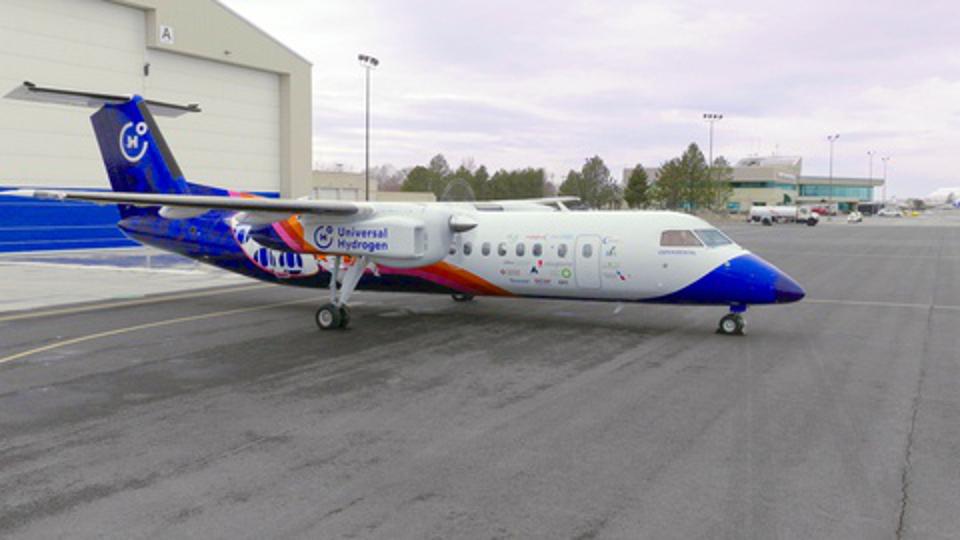Aviation has always moved forward on the wings of dreamers. From the Wright Brothers to the visionaries who built the Boeing 747, queen of the skies for 50 years, dreamers have pushed past doubters to build an industry that flew more than 4.5 billion people in 2019. But with aviation accounting for 3% of greenhouse gas emissions being poured into our atmosphere, can tech dreamers and problem-solvers address its impact on climate change?
One such dreamer is Paul Eremenko, Co-Founder & CEO of Universal Hydrogen. The company has scheduled a flight this week that just might change the face of aviation.
A converted De Havilland Canada Dash 8-300 turboprop is set to take off from Grant County International Airport in central Washington, near Moses Lake. The Dash-8, a popular regional airliner, has been converted to run on a hydrogen tank supplied by Universal Hydrogen.
If the test is successful, Universal Hydrogen says the Dash-8 will be the largest aircraft ever flown on hydrogen power. The company (website motto “Fueling Carbon-Free Flight”) is also working on a similar project in Europe, transforming another regional airliner, the ATR-72 into a hydrogen-powered craft. The conversion of the planes involves removing seats from the back of the passenger cabin and replacing them with two large hydrogen tanks via a large door cut into the fuselage.
Still, the converted Dash-8 could still theoretically carry 40 passengers. As the Universal Hydrogen website says, “Our mission is to put aviation on a trajectory to meet Paris Agreement emissions targets by making hydrogen-powered commercial flight a near-term reality.”
Pilot programs involving hydrogen, electric power and sustainable aviation fuel (SAF) have all been tested as possible replacements for kerosene-powered jet engines. But despite the deployment of more fuel-efficient aircraft and efforts to bring down the cost of sustainable aviation fuel (SAF), the need for energy to push huge planes through the sky has so far stubbornly resisted decarbonization.
But now, as MIT Technology Review puts it, “Hydrogen is having a moment… green hydrogen—generated using renewable electricity—is becoming more available, and cheaper.” Hydrogen-powered cars are available from Toyota, Honda and Hyundai, and California is slowly building out a limited network of hydrogen filling stations.
Aviation giant Airbus and startup ZeroAvia have been working on aviation applications for hydrogen as well. ZeroAvia, funded by United and American Airlines, plus Bill Gates’s energy venture fund, flew a 19-seat Dornier 228 with a hydrogen powertrain in January of 2023.
Still, Universal Hydrogen’s De Havilland Dash-8, which in standard configuration can hold up to 78 passengers, will be the largest aircraft yet to fly using hydrogen electric technology. The aft seats were removed for the hydrogen storage tank, but the aircraft still has 40 seats; the Dornier 228 tested by ZeroAvia removed all its seats for the storage and propulsion system.
It’s often said that “hydrogen” vehicles are really electric vehicles with a hydrogen fuel cell that mixes hydrogen and oxygen to create water vapor that generates electricity. As a test bed, Universal Hydrogen’s Dash-8 will fly with hydrogen fuel cells powering one engine while the other runs on traditional fuel.
Universal Hydrogen CEO Eremenko’s Twitter biography notes that he is the former CTO of Airbus and United Technologies, and that he formerly worked at DARPA, the Defense Advanced Research Projects Agency. Universal Hydrogen is based at Hawthorne Municipal Airport in Los Angeles, where their neighbor is SpaceX and Elon Musk often parks his jet.
Ultimately Universal Hydrogen hopes to change airport infrastructure by supplying hydrogen-filled “modules” made by the company. Hydrogen would be made at a plant, put into modules and shipped to aircraft as ready-made fuel tanks.
While the Dash-8 will be, as Eremenko notes the largest aircraft to fly on hydrogen fuel cells, the storage volume of hydrogen current makes it impractical for long transatlantic or transpacific flights. Universal is focusing on regional aircraft, such as the Dash-8, the ATR and perhaps twin-jet passenger planes.
Eremenko told Bloomberg he believes synthetics and biofuels are “probably the biggest fraud ever perpetrated by the industry,” as he thinks they are inefficient and really not very climate friendly.
But will there be enough hydrogen and jet engines that can power aircraft anytime soon? Airbus, which showed a scale-model hydrogen-powered concept at the Farnborough Airshow last year, is targeting 2035 as a realistic hydrogen aircraft date. Until now, the technology has moved slowly; hydrogen powered cars have been available since 2013, yet there are still just 15,000 in the US.
Stil, Universal Hydrogen has almost 250 orders for conversion kits for regional planes like the ATR 72-600 from 16 customers.
Universal Hydrogen has raised $100 million, and is backed by venture capital form Playground Global, Airbus Ventures, JetBlue Technology Ventures, GE Aviation and American Airlines.
Will this week’s flight convince the duopoly of aircraft manufacturers that hydrogen is the way to cut aircraft emissions? Peter Barrett, a general partner at Playground Global, told Bloomberg, “Boeing and Airbus will not shift until they have to. Well, they do have to because the world is on fire and drowning.”

